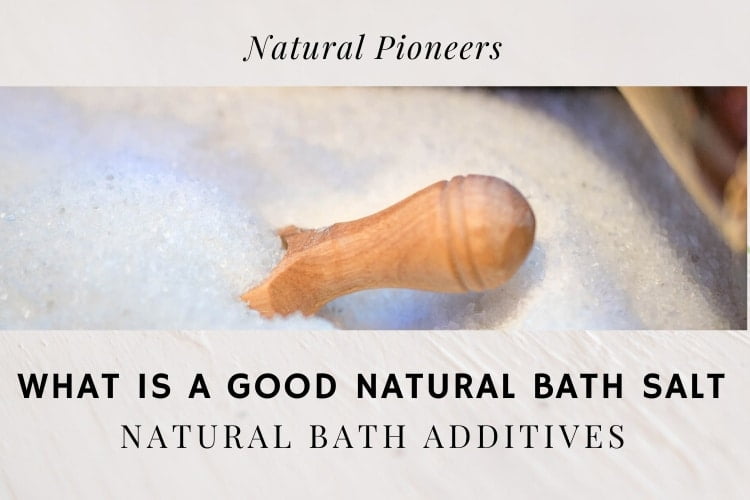
The market is crowded with bath additives. But which ones are natural and beneficial for our skin? This article will walk you through evidence-based benefits and empty claims of sea salt, Dead Sea salt, Epsom salt, colloidal oatmeal, rice starch and bath oils.
A good natural bath salt is sea salt or Dead Sea salt. Dead Sea salt is beneficial when treating rheumatologic diseases, psoriasis, redness and dry skin. Despite the popularity of Epsom salt, there is no evidence for its ingredient magnesium sulfate to be absorbed through human skin.
Let’s start with the benefits of hot baths.
1. Hot Baths | Health Benefits
Who doesn’t enjoy a nice hot bath after a busy day. The warmth seems to facilitate mental and physical relaxation within seconds, and after a couple of deep breaths we’re completely absorbed by this blissful indulgence.
Additionally, science has conducted numerous studies on hot baths that illustrate their impact on our well-being.
Benefits of hot baths:
- Hot baths combat chronic low-grade inflammation [1]
- Hot baths reduce fasting glucose and improve overall glucose metabolism [2]
- Heat therapy has widespread effects on vascular function and may improve cardiovascular health especially in individuals with limited exercise capabilities [3]; [4]
- Hot baths help with insomnia: Hot baths (40–40.5°C) before bed result in significantly “deeper” and more restful sleep [5]
- Hot baths help with type 2 diabetes: Hot baths activate HSP72, which blocks inflammation and protects against obesity-induced insulin resistance [6]
- Hot water bathing (~40°C) is commonly used in Japan. Studies find that hot water bathing results in significantly better general health and mental health, including: lower stress, lower tension-anxiety, lower anger-hostility, and lower depression levels [7]
- Hot baths, but not shower bathing, induces increased blood flow and metabolic waste elimination [8]
But what kind of bath additive should we use? Bath salt? Oil? Rice starch? Oatmeal? Or traditional additives like Epsom salt or sea salt from the Dead Sea?
Let’s explore what science has in store for each of them to find the best bath additive for your well-deserved me-time.
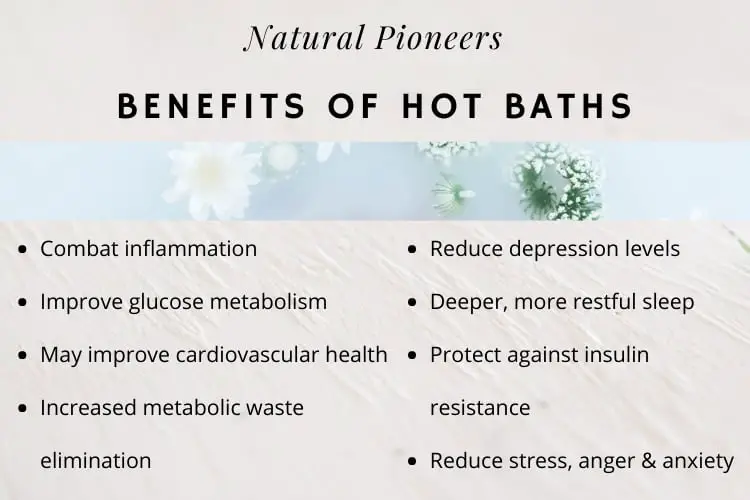
2. Rice Starch Bath Proves Beneficial For Damaged Skin
Especially when dealing with damaged skin or eczema, it’s crucial to understand what works and what might worsen it.
In young children, emollient bath additives are commonly used when battling with eczema. However, studies find no added benefit from including emollient bath additives in the standard management of eczema in children. [9]
The standard management of eczema includes leave-on emollients. For young children, additional emollient baths seem to add no further benefit.
Adults, especially women using various cosmetic products commonly suffer from SLS (sodium lauryl sulfate) damaged skin. SLS is a common ingredient in beauty products, washes, cleaning products and even toothpaste.
Rice starch as a bath additive has shown beneficial when treating SLS-damaged skin: 15 min baths twice a day in bath water with added rice starch led to a 20% improvement on the healing capacity of damaged skin. Rice starch powder is a recommended skin repair bath additive for barrier damaged skin. [10]
One study found that starch‐fortified turmeric baths improve psoriasis and can be used as a safe and inexpensive therapy in the management of psoriasis. [11]
How To Do A Rice Starch Bath:
- Start running warm water into a clean bathtub. Be sure it’s not too hot as hot water can aggravate inflamed skin and draw moisture from your skin.
- Add about 1/2 cup of rice starch powder and mix with your hand until the starch has completely dissolved.
- Once the water has reached the proper level, the bath water should be milky and have a silky feel on your skin.
Conclusion: For eczema and damaged skin, studies on rice starch led to a 20% improvement on the healing capacity of damaged skin. About 1/2 cup of rice starch powder per bath tub has shown to be effective for skin repair.
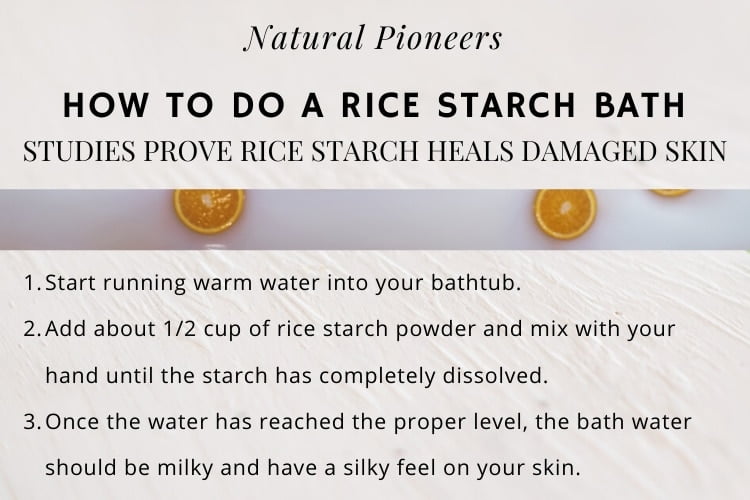
3. Oatmeal Bath Helps Relieve Rashes, Eczema & Itching
Colloidal oatmeal is a centuries-old treatment for a variety of skin conditions, including skin rashes, erythema, burns, itch, and eczema. Colloidal is a term defining the tiny size of the oat particles. Colloidal oatmeal has particles ranging between 1 and 1000 nanometers in diameter, much smaller than can be achieved in a home setting.
Colloidal oatmeal is processed from whole oats, including the bran, whereas store-bought oat flour is made from oats with bran removed and has a much larger particle size.
Composition and beneficial properties of colloidal oatmeal: [12]
- Proteins: Help maintain the skin barrier
- Polysaccharides and lipids: Replenish the skin barrier
- Vitamin E: Antioxidant
- Saponins: Cleansing
- Enzymes: Antioxidants
One study done with a colloidal oatmeal skin protectant lotion found colloidal oatmeal to be effective in treatment of dry, irritated skin. The anti-inflammatory and antioxidant activities of colloidal oatmeal may be the reason for its effectiveness. [13]
Colloidal oatmeal has been shown beneficial in the treatment of atopic dermatitis. [14]
Colloidal oatmeal not only forms a protective film on the skin but also aids in the water-binding and moisture-retention properties. In addition, colloidal oatmeal also can serve as a pH buffer helping to maintain skin surface pH. [15]
After 4 weeks of using a colloidal oatmeal regimen (twice daily use of colloidal oatmeal cleanser and colloidal oatmeal cream), studies demonstrated an overall improvement in skin condition including itch-relief. [16]
Curious about how to make your own colloidal oatmeal at home?
How To Make Colloidal Oatmeal | Homemade Recipe & Benefits
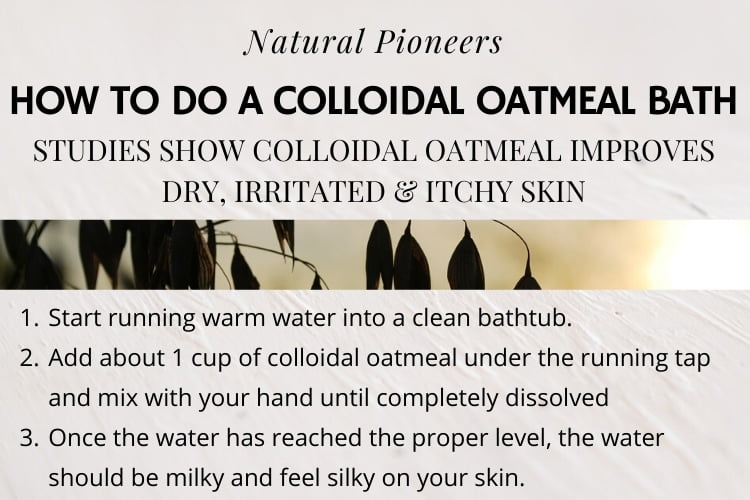
How To Do A Colloidal Oatmeal Bath:
- Start running warm water into a clean bathtub. Be sure it’s not too hot as hot water can aggravate inflamed skin and draw moisture from your skin.
- Add about 1 cup of colloidal oatmeal under the running tap and mix with your hand until completely dissolved.
- Once the water has reached the proper level, the water should be milky and feel silky on your skin.
Related Questions:
Is colloidal oatmeal the same as regular oatmeal?
The difference between colloidal oatmeal and regular oatmeal is the particle size. Colloidal oatmeal has particles ranging between 1 – 1000 nanometers, much smaller than can be achieved in a home setting. To achieve the evidence-based benefits of colloidal oatmeal, we recommend buying a product in with that exact particle size or using our recipe.
Can I make my own colloidal oatmeal?
Yes, you can. You can find our recipe here.
Colloidal oatmeal vs. oat flour
The difference between colloidal oatmeal and oat flour is the size of the oat particles. Colloidal oatmeal has particles ranging between 1 – 1000 nanometers. Unlike colloidal oatmeal, store-bought oat flour is made without the oat bran and has a much larger particle size.
Conclusion: Hot baths with colloidal oatmeal show anti-inflammatory and antioxidant activities that are beneficial for overall skin improvement, treating dry, irritated and itchy skin, as well as atopic dermatitis. Colloidal oatmeal baths have proven moisture-retention properties and serve as a pH buffer helping to maintain skin surface pH.
4. Epsom Salt | No Scientific Evidence
Epsom salt, also called magnesium sulfate is a chemical compound made up of magnesium, sulfur, and oxygen. It gets its name from the town Epsom in England, where it was originally discovered.
I’ve personally used Epsom salts for a long time. Throughout my athletic career and later in addition to running & pilates. Whereas I could never say that the salt made a noticeable difference, I certainly believed so because – well, it’s just something everyone knows.
When our team at Natural Pioneers researched the scientific database, we were frozen in shock. None, not one single study done on Epsom salts can find scientific evidence for all its imposed health benefits.
For those of you who are unfamiliar with Epsom salts, here’s the idea behind it:
Epsom salt has been traditionally used as a component of bath salts. When Epsom salt is dissolved in water, it releases magnesium and sulfate ions. These particles are supposedly absorbed through our skin, providing our bodies magnesium and sulfates. [17]
Athletes use it to soothe sore muscles, and many people swear by an Epsom salt bath in order to wind down after a busy day.
While the benefits of orally taken magnesium have long been studied (Benefits Of Water High In Magnesium), we still lack evidence for magnesium to be absorbed through our skin. [18]; [19]
How To Do An Epsom Salt Bath:
- Start running warm water into a clean bathtub. Be sure it’s not too hot as hot water can aggravate inflamed skin and draw moisture from your skin.
- Add about 2 cups of Epsom salt under the running tap and mix with your hand until completely dissolved.
- Enjoy!
Concusion: Based on current studies, there is no evidence for magnesium to be absorbed through human skin. While hot baths alone provide several proven health benefits, we cannot recommend Epsom salts as a bath additive.
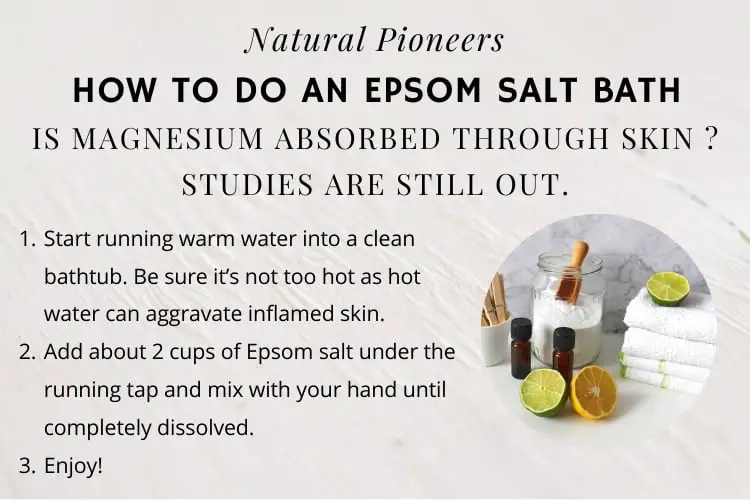
5. Sea Salt & Dead Sea Salt | Benefits
Whereas the scientific evidence on Epsom salts was scarce, sea salt, particularly from the Dead Sea, seems to be more promising.
Both, sea salt and Dead Sea salts show health benefits when used in hot baths. However, studies found the effects of Dead Sea salts to be superior to common salt. [20]
The Dead Sea is the biggest natural saline reserve in the world. Dead Sea mud and salts showed high concentrations of sulfates and mineral salts and have been used for a long time in wound healing, rheumatoid arthritis, joint diseases, skin disorders and aging effects. [21]; [22]; [23]
Moreover, Dead Sea baths are beneficial when treating psoriasis and have a good safety profile. Dead Sea salts are safe: The laboratory analysis of Dead Sea mud did not reveal mineral concentrations that could represent a health concern for their intended use. [24]; [25]; [26]
Studies show that bathing in a Dead Sea salts solution significantly improved skin barrier function compared with tap water. Inflammation shown as skin roughness and redness were significantly reduced after bathing in the Dead Sea salts solution. [27]
Furthermore, bathing in a Dead Sea salts solution enhanced skin hydration in dry skin. [28]
How To Do A Sea Salt / Dead Sea Salt Bath:
- Start running warm water into a clean bathtub. Be sure it’s not too hot as hot water can aggravate inflamed skin and draw moisture from your skin.
- Add 1 cup of sea salt or 1/2 cup of Dead Sea salts under the running tap and mix with your hand until completely dissolved. If using Dead Sea salts, it will leave a mud film on the tub – it wipes off easily.
- Enjoy!
Related Questions:
Dead Sea salts vs. Himalayan salt
The difference between Himalayan salt and Dead Sea salts lies in their mineral composition. Himalayan salt consists of about 98% sodium and some trace minerals, giving it the natural pink coloring. Dead Sea Salts differs greatly from other sea salts in mineral content, being made up of mostly magnesium and potassium (~60%), 8% salt and some rare minerals, Dead Sea salts are not safe for consumption and taste quite bitter. [29]
Can I use sea salt instead of Dead Sea salts?
Both, sea salt and Dead Sea salts are a beneficial addition to your bath. However, studies show an enhanced beneficial effect of Dead Sea bath salts compared to common salt. [30]
Dead Sea salts or Epsom salt
The difference between Dead Sea salts and Epsom salt is their mineral composition. Numerous studies show Dead Sea salts to be beneficial when treating rheumatologic diseases, psoriasis, redness and dry skin. Epsom salt contains only one mineral: Magnesium sulfate. Studies are unable to show evidence for magnesium to be absorbed through our skin. Despite its popularity, the health benefit of Epsom salt remains questionable.
Conclusion: Studies show that sea salt and Dead Sea salts are beneficial additives to hot baths. Additionally, Dead Sea salts is beneficial when treating several rheumatologic diseases, psoriasis, redness and dry skin. Dead Sea salts have also been shown to hydrate dry skin and is considered safe according to laboratory analyses.
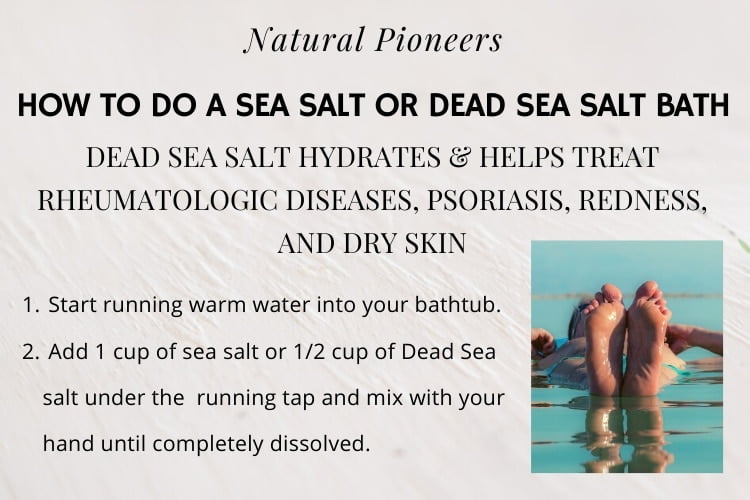
6. Bath Oil | Hydration Vs. Aroma
When looking at bath oil, studies show mixed results when evaluating the benefits of bath oil on human skin. There are large differences between the products when it comes to their irritant potential.
Some did not irritate skin more than water, whereas others demonstrated considerably damaging effects. Moreover, a study found some oil products to be damaging even after rinsing with water. Thus, instead of protecting the skin, some formulations may cause damage and delay recovery for patients with eczema. [31]
When oils are used in very small doses for scent and aromatherapeutic purposes, studies find beneficial health links.
Studies show benefits of aroma-therapeutic bath oils:
- Aromatherapy may benefit in physiological, spiritual and psychological areas and serve as a helpful tool in prevention as well as acute and chronic stages of disease. [32]
- Deeper & more restful sleep: In young infants, lavender bath oil reduces stress & crying and enhances sleep. Lavender-scented baths before bed resulted in more deep sleep after bath. [33]
- Relaxation & Anti-anxiety: Studies indicate an anti-anxiety effect of sweet orange aroma, giving scientific support to its use as a tranquilizer by aromatherapists. [34]; [35]; [36]
- Reduced sensitivity to headaches: Studies show significant reduction in sensitivity to headaches by using a combination of peppermint oil and ethanol. [37]; [38]
- Increased cognition: The combination of peppermint oil, eucalyptus oil and ethanol can increase cognitive performance while having a muscle-relaxing and mentally relaxing effect [39]
- Migrane relief: Studies on chamomile oil show relief of migraine pain [40]
Conclusion: Whereas the application of oil on skin during hot bath may potentially cause more skin damage, oils in small doses for aromatherapeutic effects prove beneficial. According to studies, especially lavender oil, sweet orange oil, peppermint oil, eucalyptus oil and chamomille oil seem to be worthy bath additives.

5. Conclusion And Recommendation
When looking for a good natural bath salt, simple sea salt and Dead Sea salt show proven health benefits. Dead Sea salt is beneficial when treating several rheumatologic diseases, psoriasis, redness and dry skin. Dead Sea salt has also been shown to hydrate dry skin and is considered safe according to laboratory analyses.
Despite the popularity of Epsom salt, there is no evidence for its ingredient magnesium sulfate to be absorbed through human skin. While hot baths alone provide several proven health benefits, we cannot recommend Epsom salts as a bath additive.
Beneficial alternatives to bath salt are colloidal oatmeal or rice starch.
Colloidal oatmeal shows anti-inflammatory and antioxidant activities that are beneficial for overall skin improvement, treating dry, irritated and itchy skin, as well as atopic dermatitis. Colloidal oatmeal baths have proven moisture-retention properties and serve as a pH buffer helping to maintain skin surface pH.
For eczema and damaged skin, studies on rice starch led to a 20% improvement on the healing capacity of damaged skin. About 1/2 cup of rice starch powder per bath tub has shown to be effective for skin repair.
Bath oils appear to be a controversial topic. Whereas the application of oil on skin during hot bath may potentially cause more skin damage, oils in small doses for aromatherapeutic effects prove beneficial. According to studies, especially lavender oil, sweet orange oil, peppermint oil, eucalyptus oil and chamomille oil seem to be worthy bath additives.
